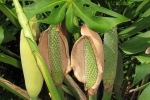This indoor plant is very common in homes or office space due to its increased strength in a very different way; this flower is always in a state of vegetation. The Captiva is a tropical plant that winds through forests.

In South and Central America the plant life starts when rising from a tiny seed, from the forest floor. The slim tiny seedling leaves then grow in the shade, looking for a tree to climb. When they reach the top of the tree they have the size of dinner plates and are also a piece of Swiss cheese whole – hence the popular name of the flat.
After a while, Monstera deliciosa climb down the tree trunk. The leaves get shrink and, when the plant touches the ground, another tree is looking to host. As this cycle repeats the oldest portion of Swiss cheese plant dies, while the young continue to grow and so the circuit is repeating.
It has a short stem and nodes, with aerial roots, with which the plant is supported as they grow; the leaves are large, leather, dark green, notched and perforated at the edges, 25-90 cm long and 25 – 75 cm wide.
In natural environment, the plant blooms and produces edible fruit. In artificial culture, young plants can lead tutors vertical coconut. The fruit, which is about 25 cm, having a diameter of 3-4 cm has a corn appearance.
When the plant blooms for the first time, the fruits contain so much oxalic acid, that are poisonous, causing immediate irritation and blistering pain, itching, loss of voice or hillock.
It takes several years before the fruits ripen and become inoffensive. After the mature fruits are eaten by people in some areas they say these fruits have a pleasant aroma and the taste is all about a mixture of banana and pineapple.
In artificial conditions, Monstera deliciosa must be placed in a location with partial shade or filtered light.
The soil should be made by a mixture of 2 parts of peat and moss, 2 parts of sand and 1 part clayey soil, and must be kept constantly moist.
Through spring and summer, during development, the plant must be treated with a liquid fertilizer, weekly.
Monstera deliciosa is multiplied by cuttings at the fastest strain. They must have aerial roots. You mush take cuttings and planting them in pots; any other operations can be made at any time of the year.
Monstera Deliciosa Pictures Gallery



